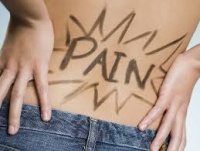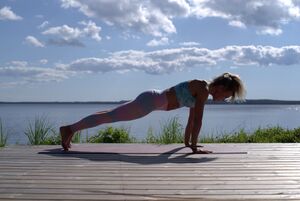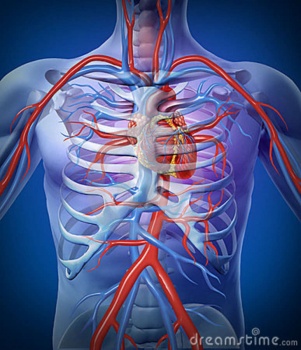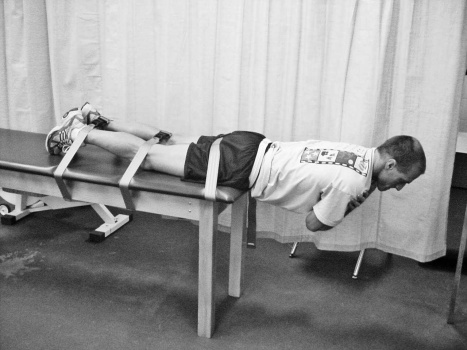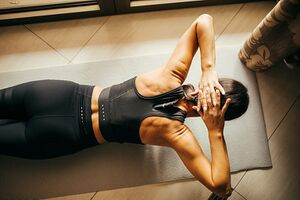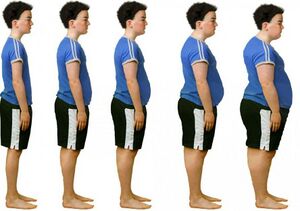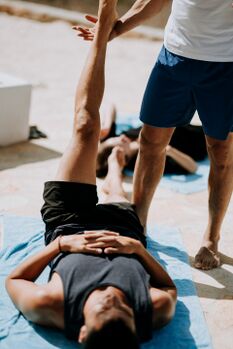Fitness and Low Back Pain
Original Editor - Peter Copeland, George Smith, Bryn Roberts as part of the Nottingham University Spinal Rehabilitation Project
Top Contributors - Peter Copeland, George Smith, Lucinda hampton, Bryn Roberts, Kim Jackson, Laura Ritchie, Evan Thomas, WikiSysop, Wanda van Niekerk, 127.0.0.1, Shaimaa Eldib, Aminat Abolade, Fahad Bin Aftab and Admin
Introduction[edit | edit source]
Low back pain (LBP) is an umbrella of conditions with 80% of adults estimated to experience LBP at some point during their life [1]. Low back pain refers to pain between the bottom of the ribs and the buttock crease.
- A high physical fitness level, and especially muscle endurance in the back muscles, is associated with lower risk of back pain[2]
- A harmful misconception is that exercise should be avoided when LPB is present. Understandably, many patients are reluctant to exercise out of the fear that any exercises or stretching will aggravate their existing back pain. They may become reluctant to exercise and rely on medications.[3]
- Physical activity (PA) to increase aerobic capacity and muscular strength, especially of the lumbar extensor muscles, is important for patients with chronic LBP in assisting them to complete activities of daily living.[4]
This article focuses on non specific chronic low back pain (NSCLBP) and its relations with fitness.
Fitness [edit | edit source]
Physical fitness is a set of attributes that people have or achieve. Being physically fit has been defined as the ability to carry out daily tasks with vigour and alertness, without undue fatigue and with ample energy to enjoy leisure-time pursuits and meet unforeseen emergencies[5]
Being physically fit depends on how well a person fulfils each of the components of being healthy.When it comes to fitness, these components are[6]:
- Cardiorespiratory Endurance - VO2 max per Kg of body mass [7]
- Muscular Endurance - Currently no Gold Standard measurement for muscular endurance
- Muscular Strength - There are a number of ways to measure muscular strength. The Biering-Sorenson Test. is an easy to perform test for back strength. Isokinetic Dynamometry is the gold standard re back strength but is very expensive. [8]
- Body Composition:- The current Gold Standard is a Four-Compartment model of measurements most commonly consisting of Mass, Total Body Volume, Total Body Water and Bone Mineral Content.[9]
- Flexibility - Optical Gold Standards such as the Vicon Motion Tracking System[10]
The following sections will look at each of these components individually, relating it to LBP.
Cardiorespiratory Endurance[edit | edit source]
Cardiorespiratory endurance indicates how well the body can supply fuel during physical activity via the body’s circulatory and respiratory systems.
Aerobic activities that help improve cardiorespiratory endurance are those that cause an elevated heart rate for a sustained period of time. eg swimming, brisk walking, jogging, cycling[6]
LPB relevance
- Aerobic exercise increases the blood flow and nutrients to the soft tissues, including those in the back, hastening the the healing process.
- Thirty minutes of aerobic exercise increases the body’s production of endorphins, a natural alternative for pain relief for the body. This helps with clients pain levels and may reduce reliance on medication for pain.
- A low aerobic fitness level is associated with CLBP
- Maximum oxygen consumption (VO2max) is found to be significantly lower by 10 mL/kg in men and by 5.6 mL/kg in women with CLBP compared to men/women without.[3]
Muscular Endurance [edit | edit source]
Fitness also includes muscular endurance, which is the ability of a muscle to continue exerting force without tiring.[6]
- Patients with low back pain have reduced lumbar extensor muscular endurance in comparison with non-sufferers.[11] [12]See Biering-Sorenson Test.
- Abdominal muscular endurance in low back pain sufferers is significantly decreased in contrast to those in the normal health population [13]
- Lumbar fatigue as a result of low muscular endurance has been shown to reduce the person’s ability to sense the positioning of the lumbar spine. People with chronic LBP have impaired ability in controlling the position of the lumbar spine after a fatiguing task, leading to lumbar instability.[14]
- Patients with lower back pain, have a higher percentage of fast type I glycolytic fibres compared to the slow oxidative fibres. Fast twitch fibers contract quickly but get tired quickly, rendering them less resistant to fatigue. This makes these people more susceptible to back injury. Non-LBP people have a much higher percentage of slow twitch fibers, which are best for endurance work, as they can carry out tasks without getting tired, and are present in core muscles.[15][6]
Strength and Low Back Pain[edit | edit source]
The core is the group of trunk and hip muscles that surround the spine, abdominal viscera and hip. Core muscles are essential for proper load balance within the spine, pelvis, and kinetic chain. Core strengthening[16] has a strong theoretical basis in treatment and prevention of LBP, as well as other musculoskeletal afflictions. A reduction in core strength can lead to lumbar instability.[3] Muscle strengthening exercises form part of the NICE treatment guidelines for Early management of persistent non-specific low back pain.
The importance of the core relate to its function ie sparing the spine from excessive load and transfer force from the lower body to the upper body and vice versa.
- Having a strong, stable core helps us to prevent injuries and allows us to perform at our best.
- In order to protect the back, ideally we want to create 360 degrees of stiffness around the spine as we move, run, jump, throw, lift objects and transfer force throughout our body.
- We do this when all of the muscles in our hips, torso and shoulders work together[17]
- Exercises to activate the deep abdominal muscles including the superficial muscles, transversus abdominis muscle and the multifidus are important for CLBP patients[3].
Measures of Back Strength: For information here look at Physiotherapy Assessment section of Core Stability
Few of us will have access to a isokinetic machine to measure trunk strength, as shown in video below.
| [18] |
Body Composition [edit | edit source]
The body is composed of water, protein, minerals, and fat. A person can potentially maintain the same weight but radically change the ratio of each of the components that make up their body.
A two-component model of body composition divides the body into a fat component and fat-free component. Body fat (storage fat) in excess can increase susceptibility to chronic illness, health complications, and LBP. Numerous studies have been conducted highlighting the relationship between increased fat content and the likelihood/prevalence of lower back pain.
- A study conducted in 2003 [19] found that there was a moderate positive relationship between obesity and lower back pain, however the results were based on the BMI calculation which does not definitively measure body fat content.
- In a study conducted by Urquhart 2011 which took into account the amount of body storage fat[20] and it was evident that there was a relationship between obesity and lower back pain
- An increase in body weight alters spinal biomechanics and loading, creating excess strain to be put through certain structures eg Obesity can lead to altered body positions such as exaggerated lumbar lordosis which will cause an alteration in spinal loading mechanics.
Flexibility[edit | edit source]
Flexibility refers to the range of movement across a joint.
Flexibility is important because it improves the ability of the kinetic chain to work smoothly and can help prevent injuries. It is specific to each joint and depends on a number of variables, including the tightness of ligaments and tendons.
Relevance to CLBP
- Stretching the soft tissues in the trunk and lower limb eg Back and thigh muscles and the regions ligaments and tendons. This can help to mobilize the spine, and improve the range of motion of the spine, decreasing back pain. Stretching exercises decrease the muscle stiffness as a result of changes in viscoelastic properties, due to the decreased actin-myosin cross-bridges and the reflex muscle inhibition.[3]
- Improved range of motion assists in the spine and related areas improves the ability to complete ADLs eg lifting and bending which require trunk flexion, a complex interaction combining lumbar and hip motion[3]. Spasmodic or shortened back muscles adversely affect the complex spinal mechanics [21].
- Tightness in the hip flexors and hamstrings can lead to a Lumbar hyperlordosis, predisposing patients to lumbar facet syndrome[22]
Exercises to Decrease Low Back Pain[edit | edit source]
It has been showed by numerous studies that exercise therapy decrease low back pain and improve overall functional mobility. Here are some methods which help to decrease low back pain.
Aerobic exercise[edit | edit source]
Aerobic exercise increases the blood flow and nutrients to the soft tissues, including those in the back, hastening the healing process. low impact exercise elevates the heart rate without worsening the back pain.
- Exercise like walking or cycling help to improve circulation, strengthen the muscle of legs and back, reducing the stiffness and pain in the back.
- swimming is another great aerobic exercise that improve cardiovascular endurance, a full body workout which improve flexibility and muscular endurance.
Stretching and Strengthen Exercise[edit | edit source]
postural exercises have improved pain control and improve functional mobility on low back patient.
- Knee to Chest Stretch
- Bridges Exercise
- Cat and Cow Stretch
- Seated Lower Back Rotational Stretch
- lumbar rotation
In acute low‐back pain, exercise therapy is as effective as either no treatment or other conservative treatments.[23]
Exercise therapy appears to be slightly effective at decreasing pain and improving function in adults with chronic low‐back pain, particularly in healthcare populations.[23]
Conclusions[edit | edit source]
A Systematic Review of the Effects of Exercise and Physical Activity on Non-Specific Chronic Low Back Pain concluded thus:
A general exercise programme that combines muscular strength, flexibility and aerobic fitness is beneficial for rehabilitation of non-specific chronic low back pain. Increasing core muscular strength can assist in supporting the lumbar spine. Improving the flexibility of the muscle-tendons and ligaments in the back increases the range of motion and assists with the patient’s functional movement. Aerobic exercise increases the blood flow and nutrients to the soft tissues in the back, improving the healing process and reducing stiffness that can result in back pain.[3]
And remember the important message is that embarking on any regular exercise will be of benefit to an overall person’s health including reducing back pain. With exercise they will look and feel better.[6]
References[edit | edit source]
- ↑ Palmer KT, Walsh K, et al. Back pain in Britain: comparison of two prevalence surveys at an interval of 10 years BMJ 2000
- ↑ E spine Exercise and Fitness to Help Your Back Available:https://www.spine-health.com/wellness/exercise/exercise-and-fitness-help-your-back (accessed 1.2.2022)
- ↑ 3.0 3.1 3.2 3.3 3.4 3.5 3.6 Andersen LB, Wedderkopp N, Leboeuf-Yde C. Association between back pain and physical fitness in adolescents. Spine. 2006 Jul 1;31(15):1740-4.Available: https://pubmed.ncbi.nlm.nih.gov/16816772/ (accessed 1.2.2022)
- ↑ Gordon R, Bloxham S. A systematic review of the effects of exercise and physical activity on non-specific chronic low back pain. InHealthcare 2016 Jun (Vol. 4, No. 2, p. 22). Multidisciplinary Digital Publishing Institute.Available:https://www.ncbi.nlm.nih.gov/pmc/articles/PMC4934575/ (accessed 21.2.2022)
- ↑ President's Council on Physical Fitness and Sports: Physical Fitness Research Digest. Series 1,No.1, Washington DC,1971.
- ↑ 6.0 6.1 6.2 6.3 6.4 Medical news today What does being physically fit mean? Available:https://www.medicalnewstoday.com/articles/7181 (accessed 2.2.2022)
- ↑ Mota, Jorge, et al. "Association of maturation, sex, and body fat in cardiorespiratory fitness." American Journal of Human Biology 14.6 (2002): 707-712.
- ↑ Stark, Timothy, et al. "Hand-held dynamometry correlation with the gold standard isokinetic dynamometry: a systematic review." PM&R 3.5 (2011): 472-479.
- ↑ Wilson, J. P., Mulligan, K., Fan, B., Sherman, J. L., Murphy, E. J., Tai, V. W., ... & Shepherd, J. A. (2012). Dual-energy X-ray absorptiometry–based body volume measurement for 4-compartment body composition. The American journal of clinical nutrition, 95(1), 25-31.
- ↑ Mohamed, Abeer A., et al. "Comparison of Strain-Gage and Fiber-Optic Goniometry for Measuring Knee Kinematics During Activities of Daily Living and Exercise." Journal of biomechanical engineering 134.8 (2012).
- ↑ Andersen, J. S. (2007). Physical fitness and low back pain: Performance-based and self-assessed physical fitness as risk indicator of low back pain among health care workers and students. Det Nationale Forskningscenter for Arbejdsmiljø; Københavns universitet. Det Sundhedsvidenskabelige fakultet.
- ↑ Biering-Sorenson, F. (1984). Physical measurements as risk indicators for low back trouble over a one-year period. Spine, 9, 106-119.
- ↑ Foster, D. N. & Fulton, M. N. (1991). Back pain and the exercise prescription. Clinics in Sports Medicine, 10, 187-209.
- ↑ Taimela, S., Kankaanpää, M., & Luoto, S. (1999). The effect of lumbar fatigue on the ability to sense a change in lumbar position: a controlled study. Spine, 24(13), 1322.fckLRChicago (lumbar positioning)
- ↑ Mannion, A. F., Weber, B. R., Dvorak, J., Grob, D., & Müntener, M. (1997). Fibre type characteristics of the lumbar paraspinal muscles in normal healthy subjects and in patients with low back pain. Journal of Orthopaedic Research, 15(6), 881-887.
- ↑ Park HS, Park SW, Oh JK. Effect of adding abdominal bracing to spinal stabilization exercise on lumbar lordosis angle, extensor strength, pain, and function in patients with non-specific chronic low back pain: A prospective randomized pilot study. Medicine. 2023 Oct 13;102(41):e35476.
- ↑ Physiopedia Core Stability Available:https://www.physio-pedia.com/index.php?title=Core_Stability&utm_source=physiopedia&utm_medium=related_articles&utm_campaign=ongoing_internal (accessed 1.2.2022)
- ↑ Isokinetic System Con-Trex. 08 Isokinetic measurement trunk on Con-Trex TP trunk module.mov. Available from: http://www.youtube.com/watch?v=xEhLr5y0wBE [last accessed 29/11/15]
- ↑ Bener, A., Alwash, R., Gaber, T. and Lovasz,G. 2003. Obesity and Low Back Pain. Coll. Antropol. 27 (2003) 1: 95–104
- ↑ Urquhart, D.M. 2011, Higher Body Fat Linked to Increased Back Pain. Spine 9/1/2011 Edition. Lippincott Williams and Wilkins, Philadelphia
- ↑ Farfan, H. F. (1975). Muscular mechanism of the lumbar spine and the position of power and efficacy. Orthopaedic Clinics of North American, 6, 135-144.
- ↑ Swedan, N. (2001) Women's Sports Medicine and Rehabilitation, Lippincott Williams & Wilkins, UK.
- ↑ 23.0 23.1 Hayden J, Van Tulder MW, Malmivaara A, Koes BW. Exercise therapy for treatment of non‐specific low back pain. Cochrane database of systematic reviews. 2005(3).
